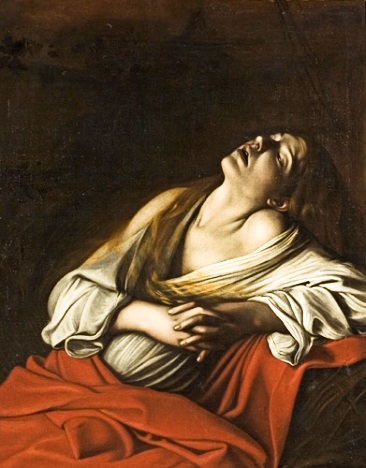
Mary Magdalen in Ecstasy, c. 1612
Oil on canvas
height: 120 cm (47.2 in); width: 100 cm (39.3 in)
Musée des beaux-arts de Marseille
In his dramatic representation of the saint, Caravaggio has stripped away her traditional symbols such as the skull and the hourglass, and tells her story as a triad of intensely emotive contrasts: red, white and black. More on this painting
Mary Magdalene, literally translated as Mary the Magdalene or Mary of Magdala, is a figure in Christianity who, according to the Bible, traveled with Jesus as one of his followers. She is said to have witnessed Jesus’ crucifixion and resurrection. Within the four Gospels she is named more than most of the apostles. Based on texts of the early Christian era in the third century, it seems that her status as an “apostle” rivals even Peter’s.
The Gospel of Luke says seven demons had gone out of her. She is most prominent in the narrative of the crucifixion of Jesus, at which she was present. She was also present two days later when, she was, either alone or as a member of a group of women, the first to testify to the resurrection of Jesus. John 20 and Mark 16:9 specifically name her as the first person to see Jesus after his resurrection.
During the Middle Ages, Mary Magdalene was regarded in Western Christianity as a repentant prostitute or promiscuous woman, claims not found in any of the four canonical gospels. More Mary Magdalene
This painting called Mary Magdalene in Ecstasy was created by Caravaggio, an Italian painter, in 1606. The piece of art depicts a very famous story about Magdalene’s redemption.
It’s said that the woman was living isolated in the southern France near Aix-en-Provence, after Christ’s death. And the remarkable moment painted by Caravaggio refers to harmonies played by celestial angels that Magdalene could hear seven times a day. So this is where the ecstasy word comes from since this deeply afflicted woman could hear melodies from heaven that gave peace to her soul. More on this painting
Michelangelo Merisi da Caravaggio (29 September 1571 in Caravaggio – 18 July 1610) was an Italian painter active in Rome, Naples, Malta, and Sicily between 1592 and 1610. His paintings, which combine a realistic observation of the human state, both physical and emotional, with a dramatic use of lighting, had a formative influence on Baroque painting.
Caravaggio trained as a painter in Milan under Simone Peterzano who had himself trained under Titian. In his twenties Caravaggio moved to Rome where there was a demand for paintings to fill the many huge new churches and palazzos being built at the time. It was also a period when the Church was searching for a stylistic alternative to Mannerism in religious. Caravaggio’s innovation was a radical naturalism that combined close physical observation with a dramatic use of chiaroscuro which came to be known as tenebrism (the shift from light to dark with little intermediate value).
He gained attention in the art scene of Rome in 1600 with the success of his first public commissions, the Martyrdom of Saint Matthew and Calling of Saint Matthew. Thereafter he never lacked commissions or patrons, yet he handled his success poorly. He was jailed on several occasions, vandalized his own apartment, and ultimately had a death sentence pronounced against him by the Pope after killing a young man, possibly unintentionally, on May 29, 1606. He fled from Rome with a price on his head. He was involved in a brawl in Malta in 1608, and another in Naples in 1609. This encounter left him severely injured. A year later, at the age of 38, he died under mysterious circumstances in Porto Ercole in Tuscany, reportedly from a fever while on his way to Rome to receive a pardon.
Famous while he lived, Caravaggio was forgotten almost immediately after his death, and it was only in the 20th century that his importance to the development of Western art was rediscovered. More on Caravaggio
Please visit my other blogs: Art Collector, Mythology, Marine Art, Portrait of a Lady, The Orientalist, Art of the Nude and The Canals of Venice, Middle East Artists, 365 Saints, 365 Days, and Biblical Icons, also visit my Boards on Pinterest
Images are copyright of their respective owners, assignees or others. Some Images may be subject to copyright
I don’t own any of these images – credit is always given when due unless it is unknown to me. if I post your images without your permission, please tell me.
I do not sell art, art prints, framed posters or reproductions. Ads are shown only to compensate the hosting expenses.
If you enjoyed this post, please share with friends and family.
Thank you for visiting my blog and also for liking its posts and pages.
Please note that the content of this post primarily consists of articles available from Wikipedia or other free sources online.
Leave a comment